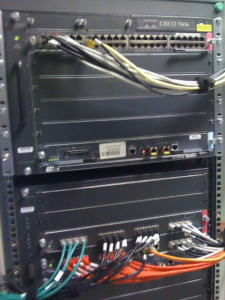Introduction to Routers and Routing
If you are interested in computer networking or work in the IT industry, you must have heard about routers and routing. Routers are critical networking devices that enable computers to communicate with each other over a network. In this article, we will introduce you to routers and routing, explain how they work, and provide you with some practical examples.
1. What are Routers?
A router is a networking device that connects different networks and enables data communication between them. In simple terms, it directs data packets between networks, making sure they reach their intended destination. Routers are responsible for determining the best path for data to travel between networks and for providing security by filtering and blocking unwanted traffic.
2. How Routers Work?
Routers work by examining the source and destination addresses of data packets and determining the best path for the packets to take to reach their destination. They use routing tables, which are databases containing information about the networks and their interconnections, to make these decisions.
Routers also use a technology called Network Address Translation (NAT) to convert private IP addresses used in local networks to public IP addresses used on the internet. NAT allows multiple devices on a local network to share a single public IP address and access the internet.
3. Types of Routers
There are several types of routers, each with its own features and capabilities. Some common types of routers are:
Wired Routers
Wired routers are the most basic type of routers and are typically used in small offices or homes. They have a limited number of Ethernet ports and provide basic network services such as DHCP and NAT.
Wireless Routers
Wireless routers are similar to wired routers, but they also have a built-in wireless access point that allows devices to connect to the network over Wi-Fi.

Core Routers
Core routers are high-end routers designed for use in large enterprise networks. They are capable of handling high traffic loads and providing advanced routing features.

Edge Routers
Edge routers are used at the edge of a network and are responsible for connecting to the internet or other external networks. They provide security features such as firewalls and VPNs.
4. Routing Protocols
Routing protocols are sets of rules used by routers to determine the best path for data to travel between networks. There are two main types of routing protocols: static and dynamic.
Static Routing
Static routing is a simple routing protocol in which the network administrator manually configures the routing table. Static routing is suitable for small networks with a limited number of devices and a simple network topology.
Dynamic Routing
Dynamic routing is a more advanced routing protocol in which routers communicate with each other to share information about network topology and traffic load. Dynamic routing protocols automatically adjust the routing table in response to changes in the network.
Distance Vector Routing
Distance Vector Routing is a type of dynamic routing protocol in which routers send updates about their routing tables to their neighbors. Distance Vector Routing uses a metric called hop count to determine the best path for data to travel between networks.
Link-State Routing
Link-State Routing is another type of dynamic routing protocol in which routers exchange information about the state of their links. Link-State Routing uses a more complex algorithm than Distance Vector Routing to calculate the best path for data to travel between networks.
5. How Routing Works?
Routing is the process of directing data packets between networks. When a device on one network wants to communicate with a device on another network, it sends a data packet to the router on its network. The router examines the source and destination addresses in the packet and determines the best path for the packet to take to reach its destination. The router then forwards the packet to the next router along the path until it reaches its final destination.
Routing can be either static or dynamic. In static routing, the network administrator manually configures the routing table. In dynamic routing, routers communicate with each other to share information about network topology and traffic load.
Routing is critical for the proper functioning of computer networks. Without routers, devices on different networks would not be able to communicate with each other.
6. Conclusion
In conclusion, routers are critical networking devices that enable devices on different networks to communicate with each other. Routers use routing tables and routing protocols to determine the best path for data to travel between networks. There are several types of routers, each with its own features and capabilities. Routing is critical for the proper functioning of computer networks.


